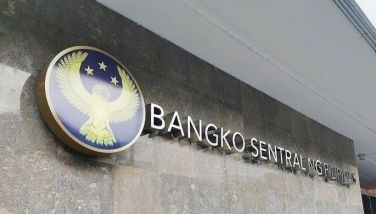Banks urged to cut NPLs to pre-’97 levels
January 16, 2006 | 12:00am
The Bangko Sentral ng Pilipinas (BSP) wants commercial banks to bring down their bad loans ratio to the level before the Asian financial crisis in 1997 of around five percent, way below the international best practice of 10 percent.
BSP Governor Amado M. Tetangco Jr. told reporters that the extension of the Special Purpose Vehicles Act (SPVA) would make another deep cut in the non-performing loans (NPL) portfolio of the commercial banking sector but efforts should not stop there.
The initial implementation of the SPVA removed a little over P100 billion worth of NPLs from the sector’s portfolio and the BSP estimated that the extension of the program would take out another P100 billion.
"That would bring the commercial banking industry’s total NPL to below seven percent of their total loan portfolio," Tetangco said. "That is not bad but our ultimate goal is to eventually bring this ratio down to pre-1997 levels."
According to Tetangco, lending to the property sector and continued sale of bad loans are the strongest factors that could make this happen, especially since there has been a slow but noticeable pick-up in residential housing development.
Like everything else in recent months, this recovery in housing development is being funded by overseas Filipino workers (OFWs) wanting to acquire acquisitions.
As a result, Tetangco said there has been a slow pick-up in commercial bank lending, leading to a steady decline in the industry’s NPL ratio.
The latest available data from the BSP indicated that the non-performing loans of the universal and commercial banking industry improved compared to 2004, going down to 9.66 percent of total loans compared to 14.21 percent last year.
The BSP said the change in ratios stemmed from the combined effect of a one-percent increase in the absolute amount of total non-performing loans (NPL) to P172.35 billion and the 1.2-percent reduction in the total loan portfolio (TLP) to P1.786 trillion.
Net of interbank loans (IBL), the BSP said the October NPL ratio was still better than last year, reaching 11.51 percent compared to 16.84 percent last year.
"If we can continue the clean-up of the NPL portfolio of banks, I don’t think it is impossible to achieve pre-1997 levels," Tetangco said.
Despite significant reforms in the country’s bank regulatory regime, however, credit rating agencies remained critical of the banking industry’s practices and structure, expressing specific apprehension over the influence of private interests.
According to Fitch Ratings, for example, the prudential and regulatory framework for Philippine banks has been substantial over recent years but enforcement continued to be a critical factor.
"The capabilities of the BSP in this regard continue to be hampered in a sector where private interests hold considerable sway over government agencies," Fitch said. "This has been highlighted in the past with banks successfully suing the BSP for wrongful closure and other actions."
In the report, Fitch said that while the BSP had made significant progress in its efforts to improve regulatory oversight and reduce banking risks, the gradual overhaul of the regulatory climate was likely to be a long-term affair.
BSP Governor Amado M. Tetangco Jr. told reporters that the extension of the Special Purpose Vehicles Act (SPVA) would make another deep cut in the non-performing loans (NPL) portfolio of the commercial banking sector but efforts should not stop there.
The initial implementation of the SPVA removed a little over P100 billion worth of NPLs from the sector’s portfolio and the BSP estimated that the extension of the program would take out another P100 billion.
"That would bring the commercial banking industry’s total NPL to below seven percent of their total loan portfolio," Tetangco said. "That is not bad but our ultimate goal is to eventually bring this ratio down to pre-1997 levels."
According to Tetangco, lending to the property sector and continued sale of bad loans are the strongest factors that could make this happen, especially since there has been a slow but noticeable pick-up in residential housing development.
Like everything else in recent months, this recovery in housing development is being funded by overseas Filipino workers (OFWs) wanting to acquire acquisitions.
As a result, Tetangco said there has been a slow pick-up in commercial bank lending, leading to a steady decline in the industry’s NPL ratio.
The latest available data from the BSP indicated that the non-performing loans of the universal and commercial banking industry improved compared to 2004, going down to 9.66 percent of total loans compared to 14.21 percent last year.
The BSP said the change in ratios stemmed from the combined effect of a one-percent increase in the absolute amount of total non-performing loans (NPL) to P172.35 billion and the 1.2-percent reduction in the total loan portfolio (TLP) to P1.786 trillion.
Net of interbank loans (IBL), the BSP said the October NPL ratio was still better than last year, reaching 11.51 percent compared to 16.84 percent last year.
"If we can continue the clean-up of the NPL portfolio of banks, I don’t think it is impossible to achieve pre-1997 levels," Tetangco said.
Despite significant reforms in the country’s bank regulatory regime, however, credit rating agencies remained critical of the banking industry’s practices and structure, expressing specific apprehension over the influence of private interests.
According to Fitch Ratings, for example, the prudential and regulatory framework for Philippine banks has been substantial over recent years but enforcement continued to be a critical factor.
"The capabilities of the BSP in this regard continue to be hampered in a sector where private interests hold considerable sway over government agencies," Fitch said. "This has been highlighted in the past with banks successfully suing the BSP for wrongful closure and other actions."
In the report, Fitch said that while the BSP had made significant progress in its efforts to improve regulatory oversight and reduce banking risks, the gradual overhaul of the regulatory climate was likely to be a long-term affair.
BrandSpace Articles
<
>
- Latest
- Trending
Trending
Latest
Trending
Latest
Recommended




























